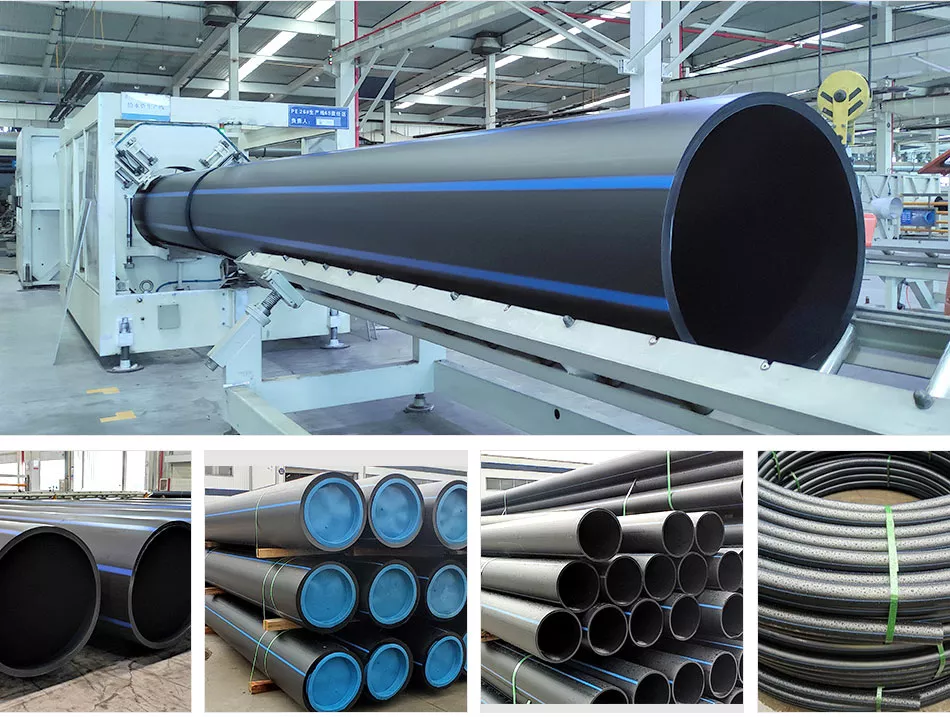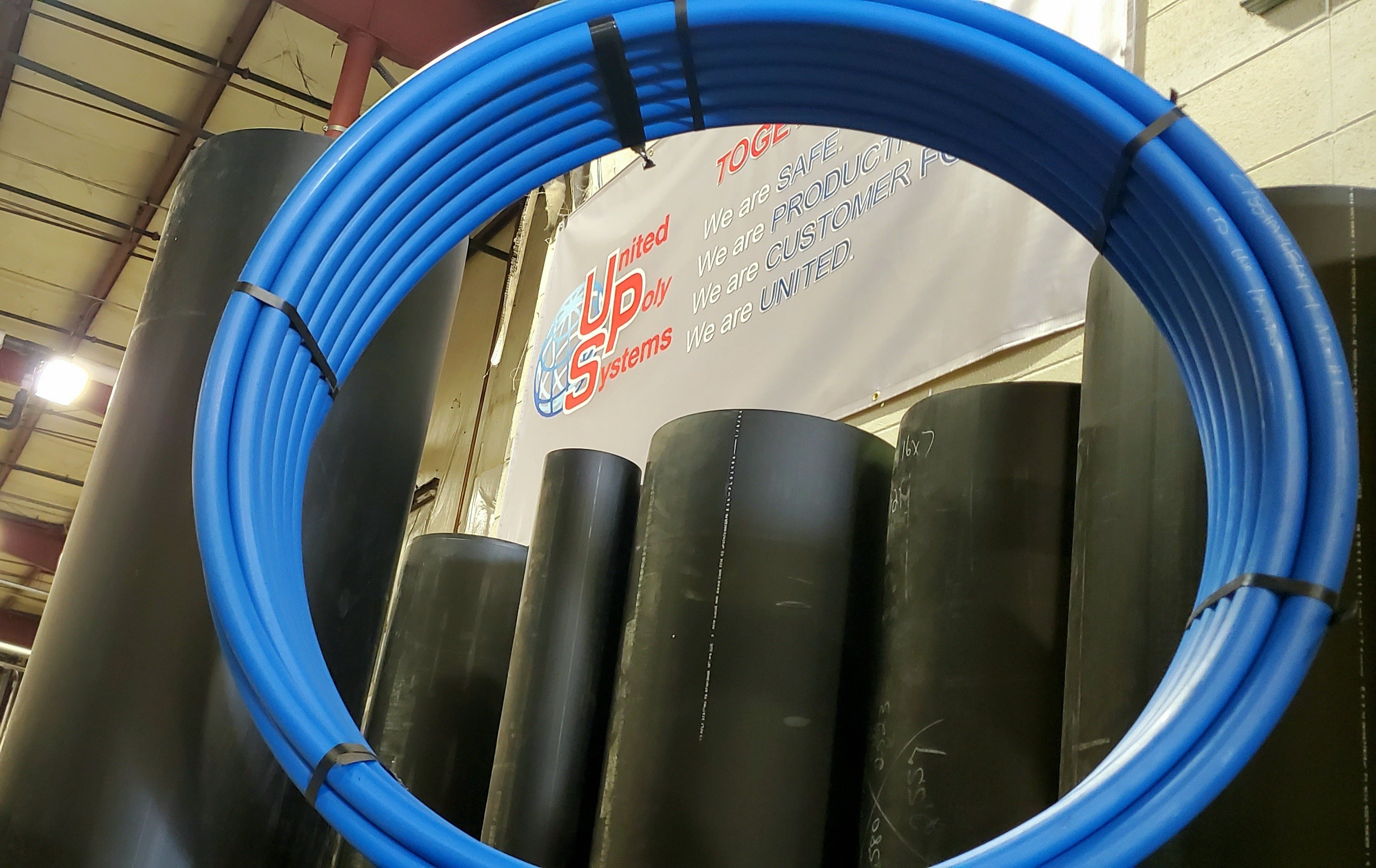hdpe pipe suppliers Midland TX: Selection Guide for Contractors
Wiki Article
Explore the Manufacturing Process Behind High-Quality HDPE Pipeline and Its Applications
The production process of premium HDPE pipes is detailed and methodical. It starts with the selection of resources that enhance efficiency. Following this, ethylene undergoes polymerization to form resin, which is then formed with extrusion. Quality assurance is extremely important, ensuring that the final item meets rigid criteria. Nonetheless, the journey of HDPE pipelines doesn't end with manufacturing. Their applications across numerous markets reveal a more comprehensive relevance worth taking a look at.Comprehending HDPE: Characteristics and Advantages

High-density polyethylene (HDPE) is a functional thermoplastic known for its sturdiness and resistance to various environmental variables. This material exhibits superb tensile strength, making it suitable for demanding applications. Its low-density framework adds to a lightweight product, promoting ease of dealing with and installation. HDPE also showcases remarkable resistance to chemicals, which minimizes destruction when exposed to severe materials.
The material's low dampness absorption better boosts its durability, making it perfect for use in pipelines and tank. Furthermore, HDPE is immune to ultraviolet (UV) radiation, making sure that products preserve their stability also when exposed to sunlight. Moreover, its flexibility enables the development of intricate shapes without endangering toughness. The environment-friendly nature of HDPE, usually originated from recycled materials, includes in its charm, advertising lasting techniques in manufacturing. Generally, these residential properties and advantages make HDPE a recommended option for different commercial and consumer applications.
Basic Material Option for HDPE Production
The selection of raw products for HDPE production is crucial to validate the last item satisfies the desired specs and quality criteria. High-density polyethylene (HDPE) is mostly created from polymerized ethylene, stemmed from nonrenewable fuel sources such as gas or petroleum. The quality of these feedstocks greatly influences the mechanical and thermal residential or commercial properties of the last HDPE.Additives likewise play a substantial function in enhancing HDPE's performance, including antioxidants, UV stabilizers, and colorants, which enhance longevity and resistance to environmental factors. The choice process should think about not just the chemical make-up of the raw materials yet also their handling qualities to guarantee reliable manufacturing.
Moreover, the sourcing of resources need to prioritize sustainability and conformity with environmental laws, as liable methods are essential in today's market. Inevitably, careful resources selection lays the structure for producing high-grade HDPE pipelines suitable for diverse applications.
The Extrusion Refine: Forming HDPE Pipe
The extrusion procedure plays a vital role fit HDPE pipelines, starting with meticulous product prep work techniques that guarantee perfect circulation and consistency. Equally crucial is the design of the die, which straight influences the final measurements and surface quality of the pipe. With each other, these elements add significantly to the efficiency and high quality of HDPE pipeline production.Product Prep Work Methods
Reliable manufacturing of HDPE pipes starts with thorough product preparation techniques, specifically the extrusion process. During this phase, high-density polyethylene material is initial dried out to remove dampness, making certain suitable flow attributes. The resin is after that fed into the extruder, where it undertakes heating and melting, changing right into a thick state. This home heating procedure is carefully controlled to keep the material's honesty and efficiency. The molten HDPE is required with a die, shaping it right into a constant pipeline kind. Appropriate temperature level management during extrusion is important, as it directly affects the product's properties and the last product top quality. When shaped, the HDPE pipe is cooled down and cut to defined sizes, prepared for subsequent handling and applications.Die Layout Significance
Accuracy in die style plays an important function in the extrusion process of HDPE pipes. The die acts as the last shaping tool, straight affecting the pipe's dimensions, wall surface density, and surface coating. A properly designed die guarantees uniform product flow, reducing flaws such as irregularities and weak points. The geometry of the die need to be enhanced to accommodate the certain buildings of HDPE, including its thickness and thermal habits throughout extrusion. Additionally, the cooling rate of the material as it travels through the die can noticeably affect the pipeline's architectural stability. Subsequently, investing in innovative die innovation is important for producers intending to produce premium HDPE pipelines that fulfill sector standards and client assumptions.Quality Assurance Measures in HDPE Manufacturing
Various elements affect the high quality of HDPE pipe production, effective quality control measures are crucial to ensure uniformity and integrity in the last item (custom hdpe pipe manufacturing Midland TX). Key quality assurance practices include strenuous product inspection, validating that the raw polyethylene fulfills well established standards for pureness and thickness. Throughout the extrusion procedure, criteria such as temperature level, pressure, and cooling time are closely checked to maintain dimensional accuracy and architectural stabilityOn top of that, post-production screening is vital; makers frequently perform hydrostatic tests to evaluate the pipe's strength and resistance to stress. Aesthetic inspections for surface area problems better improve quality control. Qualification from appropriate requirements companies, like ASTM or ISO, supplies an added layer of trustworthiness. By applying these thorough quality assurance steps, manufacturers can minimize defects, boost efficiency, and make sure that the HDPE pipelines fulfill the particular requirements of numerous applications, eventually bring about client satisfaction and count on the item.
Applications of HDPE Pipeline Across Industries
HDPE pipelines are utilized across various industries due to their toughness and adaptability. In water circulation systems, they assure efficient shipment, while in wastewater monitoring, they offer trustworthy solutions for waste transport. Furthermore, farming irrigation networks gain from HDPE's resistance to rust and flexibility, making it an optimal option for contemporary farming methods.
Water Circulation Systems
A substantial variety of sectors count on high-density polyethylene (HDPE) pipes for efficient water circulation systems. Recognized for their longevity and resistance to deterioration, HDPE pipes are extensively used in metropolitan supply of water networks, farming watering, and commercial applications. Their lightweight nature promotes very easy handling and installment, minimizing labor expenses and time. Furthermore, HDPE pipelines can suit various pressure levels, making them ideal for both low and high-pressure systems. Texas hdpe pipe manufacturer. The versatility of the material permits seamless integration into existing framework, reducing the demand for comprehensive excavation. HDPE's resistance to chemical seeping assurances that the water provided remains secure and tidy, making it an optimal selection for preserving the top quality of potable water across numerous markets.Wastewater Management Solutions
Effective water distribution systems additionally lead the method for innovative wastewater management options, where high-density polyethylene (HDPE) pipelines play a next page significant role. Popular for their longevity and resistance to rust, HDPE pipelines are perfect for carrying wastewater in numerous setups. Their adaptability permits for easy installment in complex settings, decreasing the need for comprehensive excavation. In addition, HDPE's smooth interior surface area lowers friction, improving flow rates and performance. These pipes are additionally immune to chemical leaching, making certain that contaminants do not compromise the surrounding atmosphere. Industries, towns, and therapy facilities progressively depend on HDPE pipelines for their integrity and long life, making them a preferred selection for modern wastewater administration systems. This versatility highlights the important importance of HDPE pipelines across various applications.Agricultural Watering Networks
Agricultural watering networks profit considerably from making use of high-density polyethylene (HDPE) pipes, which provide reliable and dependable water delivery to crops. HDPE pipelines are light-weight, making them easy to transport and install, drain camera inspection while their versatility permits numerous configurations in varied terrains. These pipelines demonstrate superb resistance to corrosion, chemicals, and UV radiation, making certain toughness in rough agricultural settings. Additionally, their smooth interior surface area decreases rubbing loss, maximizing water flow and reducing energy prices related to pumping. The longevity of HDPE pipes, usually surpassing half a century, adds to decrease upkeep and substitute expenses. As a result, farmers significantly count on HDPE pipes to enhance watering efficiency and advertise lasting farming practices, ultimately causing boosted crop yields and source preservation.Future Trends in HDPE Pipe Modern Technology
As the demand for lasting and reliable facilities grows, advancements in HDPE pipeline technology are poised to transform numerous industries. Emerging trends include the assimilation of smart modern technologies, such as sensors and IoT abilities, which assist in real-time monitoring of pipe problems, reducing upkeep expenses and preventing leakages. Furthermore, the advancement of innovative production techniques, such as 3D printing, is enabling the production of facility, personalized pipe designs that satisfy particular project requirements.Moreover, the focus on recycling and circular economic climate practices is driving the innovation of HDPE pipes made from recycled products, boosting sustainability. Enhanced jointing approaches, such as electro-fusion and mechanical fittings, are likewise improving installation performance and reliability. The expanding focus on environmental regulations is pushing manufacturers to take on greener manufacturing processes, making certain that HDPE pipelines not only satisfy sector requirements but likewise cultivate a more sustainable future for infrastructure growth.
Often Asked Questions
Exactly How Does HDPE Compare to Various Other Plastic Products?
HDPE exceeds lots of other plastic products concerning longevity, chemical resistance, and versatility. Its reduced thickness and high tensile stamina make it perfect for different applications, typically surpassing alternatives in both efficiency and long life.What Are the Environmental Impacts of HDPE Production?
The environmental effects of HDPE production consist of greenhouse gas exhausts, power consumption, and potential contamination from making procedures. In addition, inappropriate disposal can result in dirt and water contamination, raising problems concerning long-lasting environmental results.Can HDPE Water Lines Be Reused?
Yes, HDPE pipelines can be recycled. Numerous centers accept made use of HDPE for processing, transforming it into new items. This recycling adds to sustainability initiatives, decreasing plastic waste while saving resources and power in the manufacturing cycle.What Is the Life-span of HDPE Water Lines?

Just How Do Temperature Level Variations Impact HDPE Pipeline Performance?
Temperature variants significantly impact HDPE pipe efficiency, affecting adaptability and strength. High temperatures can cause softening, while low temperatures might trigger brittleness, inevitably affecting the pipe's durability and viability for various applications in varied environments.Report this wiki page